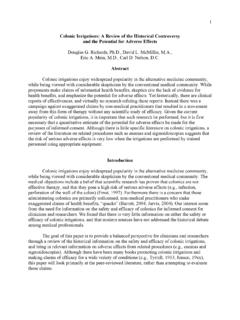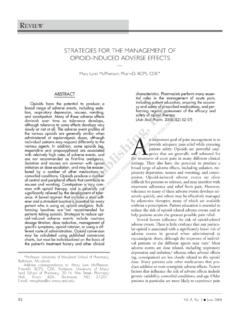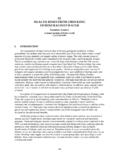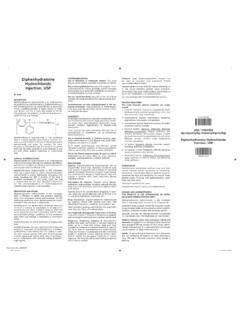Transcription of Children and other heavy metals - World Health Organization
1 11 TRAINING FOR Health CARE PROVIDERSTRAINING FOR Health CARE PROVIDERS[Date [Date ..Place Place .. ]Organizer] adverse Health EFFECTS OF heavy adverse Health EFFECTS OF heavy metals IN CHILDRENMETALS IN CHILDRENC hildren's Health and the EnvironmentWHO Training Package for the Health SectorWorld Health 2011<<NOTE TO USER: Please add details of the date, time, place and sponsorship of the meeting for which you are using this presentation in the space indicated.>> <<NOTE TO USER: This is a large set of slides from which the presenter should select the most relevant ones to use in a specific presentation. These slides cover many facets of the problem. Present only those slides that apply most directly to the local situation in the region.
2 Please replace the examples, data, pictures and case studies with ones that are relevant to your situation.>> <<NOTE TO USER: This slide set discusses routes of exposure, adverse Health effects and case studies from environmental exposure to heavy metals , other than lead and mercury, please go to the modules on lead and mercury for more information on those. Please refer to other modules ( water, neurodevelopment, biomonitoring, environmental and developmental origins of disease) for complementary information>>2 Children and heavy metalsChildren and heavy metals To define the spectrum of heavy metals (others than lead and mercury) with adverse effects on human Health To describe the epidemiology of adverse effects of heavy metals (Arsenic, Cadmium, Copper and Thallium)
3 In Children To describe sources and routes of exposure of Children to those heavy metals To understand the mechanism and illustrate the clinical effects of heavy metals toxicity To discuss the strategy of prevention of heavy metals adverse effects2 LEARNING OBJECTIVESLEARNING OBJECTIVESThe scope of this module is to provide an overview of the public Health impact, adverse Health effects, epidemiology, mechanism of action and prevention of heavy metals ( other than lead and mercury) toxicity in Children . 33 Children and heavy metalsChildren and heavy metalsWHY heavy metals ?WHY heavy metals ?WHO 10 WHO 10chemicals of major public Health concern chemicals of major public Health concern includincludingingheavy metalsheavy metals Air pollution Arsenic Asbestos Benzene Cadmium Dioxin and dioxin-like substances Inadequate or excess fluoride Lead Mercury Highly hazardous pesticides Chemicals are part of our daily life.
4 All living and inanimate matter is made up of chemicals and virtually every manufactured product involves the use of chemicals. Many chemicals can, when properly used, significantly contribute to the improvement of our quality of life, Health and well-being. But other chemicals are highly hazardous and can negatively affect our Health and environment when improperly managed. WHO compiled a list of the 10 major chemicals of concern, which includes many heavy metals : Air pollution Arsenic Asbestos Benzene Cadmium Dioxin and dioxin-like substances Inadequate or excess fluoride Lead Mercury Highly hazardous pesticides Notes from: WHO 10 chemicals of major public Health concern. Available at accessed 22 September and heavy metalsChildren and heavy metalsLight MetalsH e a v yM e t a l sNonmetalsInert TABLE PERIODIC TABLE BY GROUPS OF ELEMENTSBY GROUPS OF ELEMENTSThe periodic table or Mendeleev s table, organizes chemical elements according to their atomic number, electron configuration and valence numbers.
5 This table illustrates the groups of elements. The main heavy metals are listed below, with their atomic numbers, symbols and names:4 - Beryllium (Be)13 - Aluminum (Al)24 - Chrome (Cr)25 - Manganese (Mn)26 - Iron (Fe)27 - Cobalt (Co)28 - Nickel (Ni)29 - Copper (Cu)30 - Zinc (Zn)33 - Arsenic (As)34 - Selenium (Se)42 - Molybdenum (Mo)47 - Silver (Ag)48 - Cadmium (Ca)50 - Tin (Sn)51 - Antimony (Sb)56 - Barium (Ba)80 - Mercury (Hg)81 - Thallium (Ti)82 - Lead (Plumbum, Pb)Motivations for controlling heavy metal concentrations in gas streams are diverse. Some of them are dangerous to Health or to the environment ( Hg, Cd, As, Pb, Cr), some may cause corrosion ( Zn, Pb), some are harmful in other ways ( arsenic may pollute catalysts).
6 Within the European community, the 13 elements of highest concern are As, Cd, Co, Cr, Cu, Hg, Mn, Ni, Pb, Sn, and Ti, the emissions of which are regulated in waste incinerators. Some of these elements are actually necessary for humans in minute amounts (Co, Cu, Cr, Ni) while others are carcinogenic or toxic, affecting, among others, the central nervous system (Hg,Pb, As), the kidneys or liver (Hg, Pb, Cd, Cu) or skin, bones, or teeth (Ni, Cd, Cu, Cr).[3] heavy metal pollution can arise from many sources but most commonly arises from the purification of metals , , the smelting of copper and the preparation of nuclear fuels. Electroplating is the primary source of chromium and cadmium. Through precipitation of their compounds or by ion exchange into soils and mud, heavy metal pollutants can localize and lay dormant.
7 Unlike organic pollutants, heavy metals do not decay and thus pose a different kind of challenge for remediation. Currently, plants or microorganisms are tentatively used to remove some heavy metals such as mercury. Plants which exhibit hyper accumulation can be used to remove heavy metals from soils by concentrating them in their bio matter. Some treatment of mining tailings has occurred where the vegetation is then incinerated to recover the heavy medical usage, heavy metals are loosely defined and include all toxic metals irrespective of their atomic weight: " heavy metal poisoning" can possibly include excessive amounts of iron, manganese, aluminum, mercury, or beryllium (the fourth lightest element) or such a semimetal as arsenic.
8 This definition excludes bismuth, the heaviest of approximately stable elements, because of its low : Malko S et al. Street dust pollution of some metals along Eskisehir urban roads, Turkey. Available at accessed 22 September 2011 Zevenhoven, Kilpinen. Trace elements. Alkali metals . 2001. 8-27 Image from used with copyright permission5 Children and heavy metalsChildren and heavy metalsDEFINITIONS OF heavy METAL: A PARTIAL LISTDEFINITIONS OF heavy METAL: A PARTIAL LISTD efinitions in terms of density (SG=specific gravity)Definitions in terms of density (SG=specific gravity) metals fall naturally into 2 groups: light metals (densities < 4) and heavy metals (densities >7) (Bjerrum, 1936) metal having a (Van Nostrand, 1964) metal of high SG, especiallya metal having a SG of or greater (Merriam, 1976) metal with a density >5 (Brewer, 1983) metal with a density >6 g/cm3(Davies, 1987) metal of sg > 4 (Grant, 1987) metal with a density of or greater (Flexner, 1987) metal with a density > g/cm3(Streit, 1994) metal with a density > g/cm3(Falbe, 1996) element with a density >6 g/cm3(Thornton, 1995)5 DufusJ, 2002In medicine, heavy metals are often not well defined and include all toxic metals (including lighter ones).
9 " heavy metal poisoning" can possibly include excessive amounts of iron, manganese, aluminum, mercury, or beryllium (the fourth lightest element) or such a semimetal as arsenic. This definition excludes bismuth, the heaviest of approximately stable elements, because of its low are various definitions used for heavy metals . Many are based on specific gravity. This slide states several of these definitions. Refs: Bennet H (ed). Concise Chemical and Technical Dictionary,4th enlarged Arnold, Bjerrum N. Bjerrum's Inorganic Chemistry, 3rd Danish ed. Heinemann, London. 1936. Brewer M, Scott T (eds). Concise Encyclopedia of Biochemistry. Walter de Gruyter, Berlin, New Davies BE. Consequences of environmental contamination by lead mining in Wales.
10 , 49: 213. Falbe J, Regitz M (eds). Roempp Chemie-Lexikon. George Thieme, Flexner SB (ed). The Random House Dictionary of the English Language, 2nd ed. Random House, New Grant R, Grant C (eds). Grant and Hackh's Chemical Dictionary. McGraw-Hill, New Holister G, Porteous A (Eds.). The Environment: A Dictionary of the World Around Us. Arrow, London,1976. Lewis RJ Sr. (ed). Hawley's Condensed Chemical Dictionary, 12th Nostrand Reinhold, New York. 1993. Merriam. 3rd New International , Chicago. 1976. Streit B. Lexikon der Okotoxikologie. VCH, Weinheim. 1994. Thornton I. metals in the Global Environment: Facts and Misconceptions. International Council on metals and the Environment, Ottawa. 1995. US Environmental Protection Agency (EPA).















